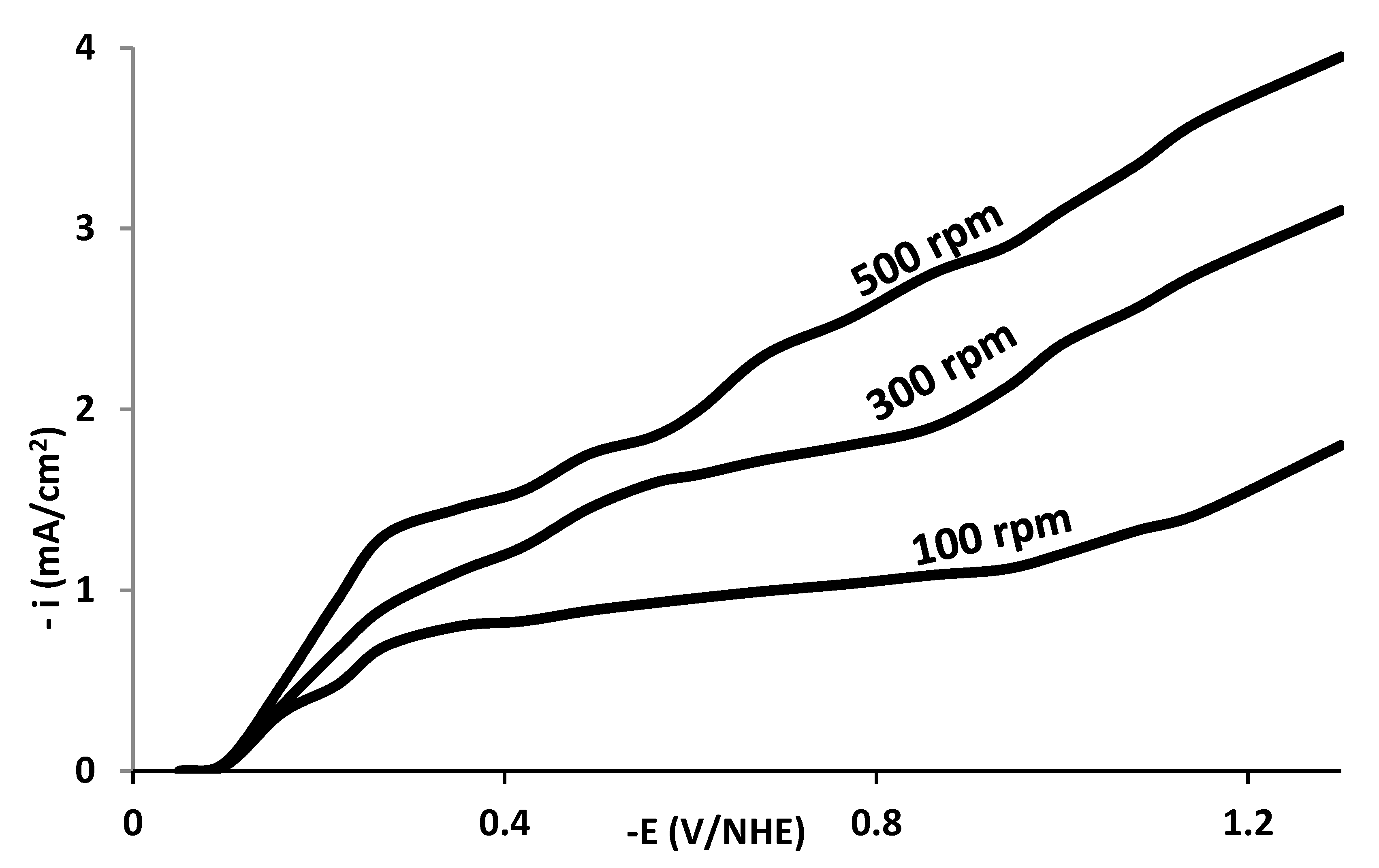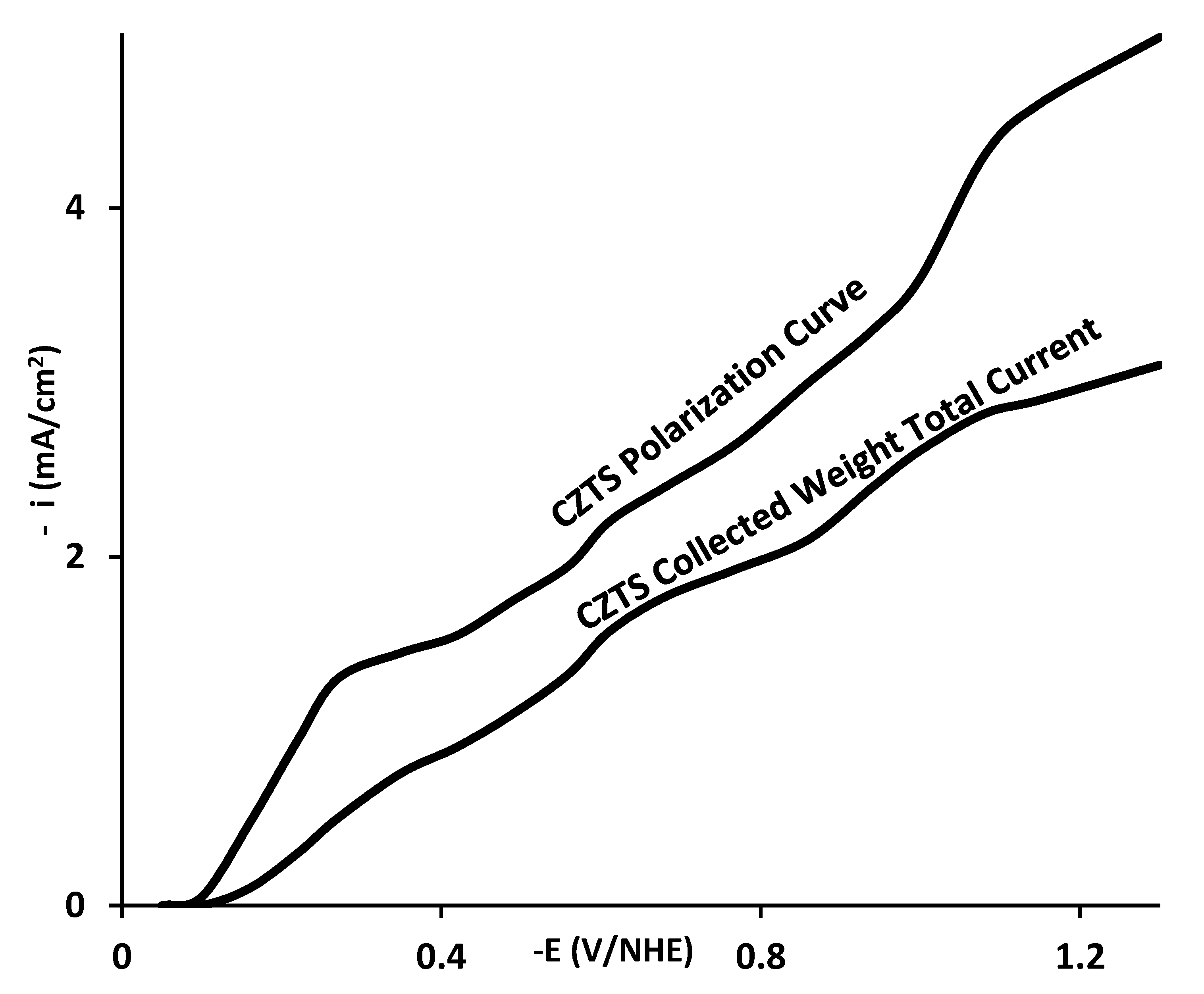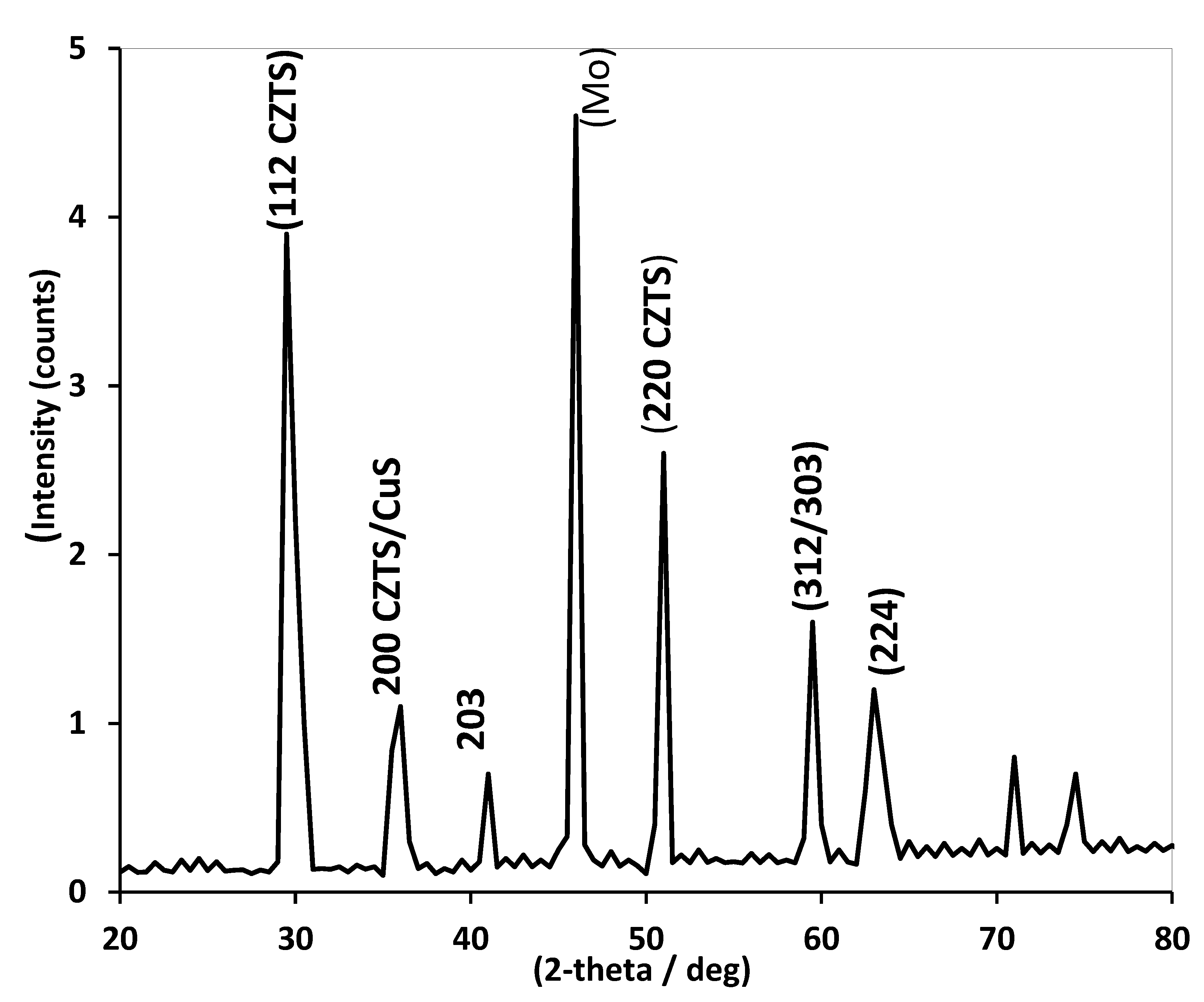Introducing a Dilute Single Bath for the Electrodeposition of Cu2(ZnSn)(S)4 for Smooth Layers
Abstract
:1. Introduction
- Waste is reduced by the exact controllable material deposition made possible by electrodeposition with low electrolyte concentration. Materials are only placed where they are required, which minimizes overuse.
- Compared to rare and costly materials like indium and gallium utilized in other thin-film technologies, many materials used in electrodeposition, such as zinc, copper, and tin, are cheap and readily available.
- Electrodeposition can be carried out at ambient temperature and atmospheric pressure, saving energy and equipment expenses in contrast to other processes requiring high temperatures or vacuum conditions.
- The technology is appropriate for mass production because it can be readily scaled from small laboratory settings to big industrial production without requiring significant setup changes compared to other production methods.
- Electrodeposition requires comparatively low-cost and essential equipment. Usually, it consists of an electrolyte solution bath, electrodes, and a power source with minimal maintenance requirements.
- The procedure tolerates fast production rates of large quantities with continuous production lines.
2. Materials and Methods
2.1. Fabrication Process
2.2. Instrumental Equipment and Techniques
2.3. CZTS Electrodeposition—Overriding Considerations
- F = Faraday’s constant;
- nj = the number of electrons transported in the electrode reaction.
3. Results
3.1. CZTS Electrodeposition
3.2. Quantifying Convective Flow Effects
3.2.1. Polarization Curves
3.2.2. Hydrogen Evolution
3.3. Thermal Annealing
3.4. Crystallography of CZTS Solar Device
4. Optical Characterization Test
5. Conclusions
Author Contributions
Funding
Institutional Review Statement
Data Availability Statement
Acknowledgments
Conflicts of Interest
References
- Agasti, A.; Mallick, S.; Bhargava, P. Electrolyte pH-dependent controlled growth of co-electrodeposited CZT films for application in CZTS-based thin film solar cells. J. Mater. Sci. Mater. Electron. 2018, 29, 4065–4074. [Google Scholar] [CrossRef]
- Chan PLam, H.; Surya, C. Preparation of Cu2ZnSnS4 films by electrodeposition using ionic liquids. Sol. Energy Mater. Sol. Cells 2010, 94, 207. [Google Scholar] [CrossRef]
- Beres, M.; Syzdek, J.; Yu, K.; Mao, S. Growth behavior of co-electrodeposited CZTS precursor thin films from acidic baths containing tartaric acid Materials. Chem. Phys. 2018, 204, 83–94. [Google Scholar] [CrossRef]
- Lin, Y.; Ikeda, S.; Septina, W.; Kawasaki, Y.; Harada, T.; Matsumura, M. Mechanistic aspects of preheating effects of electrodeposited metallic precursors on structural and photovoltaic properties of Cu2ZnSnS4 thin films. Sol. Energy Mater. Sol. Cells 2014, 120, 218. [Google Scholar] [CrossRef]
- Tang, A.; Li, Z.; Wang, F.; Dou, M.; Liu, J.; Ji, J.; Song, Y. Electrodeposition mechanism of quaternary compounds Cu2ZnSnS4: Effect of the additives. Appl. Surf. Sci. 2018, 427, 267–275. [Google Scholar] [CrossRef]
- Tang, A.; Li, Z.; Wang, F.; Dou, M.; Pan, Y.; Guan, J. One step electrodeposition of Cu2ZnSnS4 thin films in a novel bath with sulfurization free annealing. Appl. Surf. Sci. 2017, 402, 70–77. [Google Scholar] [CrossRef]
- Pawar, M.; Moholkar, V.; Kim, K.; Shin, W.; Moon, H.; Rhee, I.; Kim, H. Effect of laser incident energy on the structural, morphological, and optical properties of Cu2ZnSnS4 (CZTS) thin films. Curr. Appl. Phys. 2010, 10, 565–569. [Google Scholar] [CrossRef]
- Zhang, X.; Shi, X.; Ye, W.; Chuanli, M.; Chunming, W. Electrochemical deposition of quaternary Cu2ZnSnS4 thin films as potential solar cell material. Appl. Phys. A 2009, 94, 381–386. [Google Scholar] [CrossRef]
- Slupska, M.; Ozga, P. Electrodeposition of Sn-Zn-Cu alloys from citrate solutions. Electrochim. Acta 2014, 141, 149–160. [Google Scholar] [CrossRef]
- Tulshi, S.; Dhyey, R.; Malkeshkumar, P.; Indrajit, M.; Abhijit, R. Effect of initial bath condition and post-annealing on co-electrodeposition of Cu2ZnSnS4. Mater. Chem. Phys. 2016, 171, 63–72. [Google Scholar] [CrossRef]
- Wang, W.; Winkler, M.; Gunawan, O.; Gokmen, T.; Todorov, T.; Zhu, Y.; Mitzi, D. Device Characteristics of CZTSSe Thin-Film Solar Cells with 12.6% Efficiency. Adv. Energy Mater. 2014, 4, 1301465. [Google Scholar] [CrossRef]
- Wu, Z.; Tan, K.; Zhang, R.; Wei, Q.; Lin, Y. Atomistic kinetic Monte Carlo—Embedded atom method simulation on growth and morphology of Cu–Zn–Sn precursor of Cu2ZnSnS4 solar cells. J. Mater. Res. 2019, 35, 252–262. [Google Scholar] [CrossRef]
- Azmi, S.; Pezzato, L.; Sturaro, M.; Khoumri, M.; Martucci, A.; Dabalà, M. A green and low-cost synthetic approach based on deep eutectic choline-urea solvent toward the synthesis of CZTS thin films. Ionics 2019, 25, 2755–2761. [Google Scholar] [CrossRef]
- Toura, H.; Khattak, H.; Baig, F.; Soucase, M.; Touhami, E.; Hartiti, B. Effect of complexing agent on the morphology and annealing temperature of CZTS kesterite thin films by electrochemical deposition. Curr. Appl. Phys. 2019, 19, 606–613. [Google Scholar] [CrossRef]
- Saeed, M.; González Peña, O.I. Mass Transfer Study on Improved Chemistry for Electrodeposition of Copper Indium Gallium Selenide (CIGS) Compound for Photovoltaics Applications. Nanomaterials 2021, 11, 1222. [Google Scholar] [CrossRef] [PubMed]
- Saeed, M. Cu (InGa)(SeS)2 Electrodeposition from a Single Bath Using Pulsing Current Technique. ECS Trans. 2023, 111, 3. [Google Scholar] [CrossRef]
- Rashid, H.; Rabeya, J.; Doha, H.; Islam, O.; Reith, P.; Hopman, G.; Hilgenkamp, H. Characterization of single step electrodeposited Cu2ZnSnS4 thin films. J. Opt. 2018, 47, 256–262. [Google Scholar] [CrossRef]
- Paraye, A.; Sani, R.; Ramachandran, M.; Selvam, V. Effect of pH and sulfur precursor concentration on electrochemically deposited CZTS thin films using glycine as the complexing agent. Appl. Surf. Sci. 2018, 435, 1249–1256. [Google Scholar] [CrossRef]
- Khalil, I.; Bernasconi, R.; Magagnin, L. CZTS layers for solar cells by an electrodeposition-annealing route. Electrochim. Acta 2014, 145, 154–158. [Google Scholar] [CrossRef]
- Bhattacharya, N.; Kim, Y. Cu-Zn-Sn-S Thin Films from Electrodeposited Metallic Precursor Layers. Open Surf. Sci. J. 2012, 4, 19–24. [Google Scholar] [CrossRef]
- Lincot, D.; Guillemoles, F.; Taunier, S.; Guimard, D.; Sicx-Kurdi, J.; Chaumont, A.; Roussel, O.; Ramdani, O.; Hubert, C.; Fauvarque, P.; et al. Chalcopyrite Thin Film Solar Cells by Electrodeposition. Sol. Energy 2004, 77, 725–737. [Google Scholar] [CrossRef]
- Lincot, D. Electrodeposition of Semiconductors. Thin Solid Film. 2005, 487, 40–48. [Google Scholar] [CrossRef]








| Rotation Rate | Cu | Sn | Zn | S | |
|---|---|---|---|---|---|
| 500 rpm | Atomic % Composition | 24.93 | 14.2 | 9.9 | 50.8 |
| Weight [mg] Total Weight 1.67 mg | 0.416 | 0.237 | 0.165 | 0.85 | |
| 300 rpm | Atomic % Composition | 23.9 | 11.1 | 9.1 | 55.8 |
| Weight [mg] Total Weight 1.63 mg | 0.39 | 0.18 | 0.148 | 0.91 | |
| 100 rpm | Atomic % Composition | 23.2 | 12.8 | 9.7 | 54.1 |
| Weight [mg] Total Weight 1.2 mg | 0.278 | 0.15 | 0.116 | 0.65 |
| Metal | Before Annealing | After Annealing | Experimental Errors (%) |
|---|---|---|---|
| Copper | 23.2% | 24.93% | 4.1 |
| Tin | 15.0% | 14.2% | 3.9 |
| Zinc | 8.0% | 9.9% | 5.2 |
| Sulfur | 54.1% | 50.3% | 6.05 |
Disclaimer/Publisher’s Note: The statements, opinions and data contained in all publications are solely those of the individual author(s) and contributor(s) and not of MDPI and/or the editor(s). MDPI and/or the editor(s) disclaim responsibility for any injury to people or property resulting from any ideas, methods, instructions or products referred to in the content. |
© 2024 by the authors. Licensee MDPI, Basel, Switzerland. This article is an open access article distributed under the terms and conditions of the Creative Commons Attribution (CC BY) license (https://creativecommons.org/licenses/by/4.0/).
Share and Cite
Saeed, M.; González Peña, O.I. Introducing a Dilute Single Bath for the Electrodeposition of Cu2(ZnSn)(S)4 for Smooth Layers. Electrochem 2024, 5, 354-369. https://doi.org/10.3390/electrochem5030023
Saeed M, González Peña OI. Introducing a Dilute Single Bath for the Electrodeposition of Cu2(ZnSn)(S)4 for Smooth Layers. Electrochem. 2024; 5(3):354-369. https://doi.org/10.3390/electrochem5030023
Chicago/Turabian StyleSaeed, Mahfouz, and Omar I. González Peña. 2024. "Introducing a Dilute Single Bath for the Electrodeposition of Cu2(ZnSn)(S)4 for Smooth Layers" Electrochem 5, no. 3: 354-369. https://doi.org/10.3390/electrochem5030023
APA StyleSaeed, M., & González Peña, O. I. (2024). Introducing a Dilute Single Bath for the Electrodeposition of Cu2(ZnSn)(S)4 for Smooth Layers. Electrochem, 5(3), 354-369. https://doi.org/10.3390/electrochem5030023







